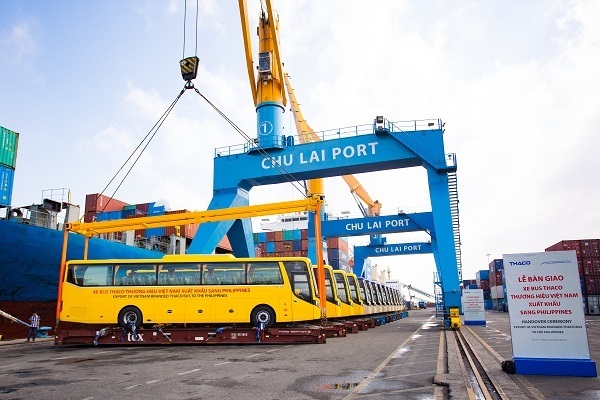Communist Party Secretary General and Vietnamese President Nguyen Phu Trong, speaking about Vietnam’s economic achievements at the government’s year-end online conference with leaders of cities and provinces, quoted the comment by the World Bank: “Dark clouds continue to pull on the global economy with lower economic growth and trade flows than expected for 2019; however, the sun is still shining above the Vietnamese sky”.

Vietnam obtained a high GDP growth rate of over 7 percent in 2019, with total import/export turnover of $517 billion and forex reserves of $80 billion.
The World Bank described Vietnam’s economy in its report released in December 2019 in a very positive way.
| Saying that ‘the sun is still shining above the Vietnamese sky’, the World Bank has also noted that the country should not ignore risks that could occur during bad times. |
The institution said 2019 was a relatively good year for Vietnam's economy.
In the context of increasing uncertainty across the globe, Vietnam was still among the fastest growing economies in the world with an estimated GDP growth rate of approximately 6.8 percent, nearly three times higher than the world’s average growth rate (2.6 percent), and higher than the 1.2 percentage points than the average level in East Asia and the Pacific, according to the latest estimate in the World Bank report about the global economic outlook.
As such, the GDP growth rate predicted by the World Bank for 2019 was lower than the real growth rate of 7.02 percent.
After giving praise, the World Bank said since the risk about bad days cannot be ignored, the government is right to pay attention to developing the private sector, considering this is the channel that offsets decline in external demand.
However, private enterprises in Vietnam still have to face many obstacles, especially in seeking long-term financial sources.
This is a structural bottleneck. Private enterprises have become the major driving force for growth, but they are still blocked and bear discriminatory treatment.
Private enterprises face serious obstacles
In the report, the World Bank recommends that the government of Vietnam step up the process of developing the private sector. It warned that many enterprises are facing serious obstacles that hinder their development.
A survey conducted in 2016 by the World Bank found that the low opportunity for financial access is the biggest obstacle, followed by unhealthy competition and workers’ qualifications.
Therefore, dealing with enterprises’ obstacles in financial access should be a priority if the government wants to maintain high growth.
The private sector cannot access loans because bank's credit allocation has so far been inclined to the state sector, including state-owned enterprises (SOEs).
According to the General Statistics Office (GSO), while the number of newly registered enterprises reached a record high of 138,000, the number of enterprises suspending business for definite time, or suspending operation for dissolution procedures, in 2019, also reached a record high of 89,200.
Private enterprises' productivity based on the added value of every worker was less than $4,000 per annum, or 2-5 times lower than SOEs and foreign invested enterprises (FIEs).
The concern is that the productivity of these enterprises appears to be on the decline because of many obstacles in for many years. The World Bank's recent report on business environment showed that though Vietnam has a relatively high ranking in comparison with other countries which have the same income per capita, it is still behind developed countries in East Asia.
Vietnam did not make much progress in recent years. It even fell one grade in 2020, after making good progress from 2010 to 2016 (up by 20 grades).
The slow upgrading shows that business environment reform has slowed down, at least in comparison with other countries.
Ousmane Dione, World Bank Vietnam Country Director:
In the past three years, no other country in the world, except Vietnam, reduced its national debt ratio. In 2017, the national debt ratio was about 63.7 percent of GDP, and the figure decreased to 56 percent GDP in 2019.
However, the decrease was the result of public investment reduction, i.e., Vietnam did not invest in new development projects that will reduce the country's development potential in the future.
For example, there has been no large investment project in the power sector in the last few years. In infrastructure, Vietnam does not have large road projects. ODA has been disbursed at the slowest pace in the last 20 years. All of this will create problems in the future.
The equitisation of state-owned enterprises is also getting stuck. In 2017, Vietnam sold Sabeco and there has been no other large equitization case since then.
Vietnam's exports was expected to increase by about 10 percent in 2019, but the overall growth rate reflected two things. On the one hand, there was strong growth in the US market (up by over 10 percentage points compared to 2018) , but on the other hand, the growth in non-US markets decreased (down by nearly 10 percentage points).
Tu Giang

Vietnam’s economy in ‘coronavirus whirlwind’
The Ministry of Planning and Investment (MPI) has predicted that the GDP would grow by 5.96 percent, a 7-year low.

Vietnam’s economy to expand 6.25% if coronavirus outbreak ends in Q1
Vietnam’s GDP growth is expected to reach 6.25% this year if the outbreak of Covid-19 is contained within the first quarter, according to the Ministry of Planning and Investment.
 Saying that ‘the sun is still shining above the Vietnamese sky’, the World Bank has also noted that the country should not ignore risks that could occur during bad times.
Saying that ‘the sun is still shining above the Vietnamese sky’, the World Bank has also noted that the country should not ignore risks that could occur during bad times.